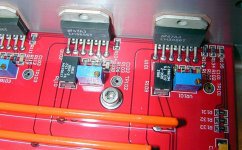Disclaimer: I do offer a competing product for sale: Neurochrome LM3886 Done Right, although, my kit is about 5x the cost of the eBay kit reviewed here, so I'm obviously not competing on price. Still, some may perceive this as a conflict of interest and I figured I should make it publicly known up front.
There are many LM3886 boards available in the market today and they all seem to implement various bits and pieces of the Typical Application schematic from the LM3886 data sheet. Some include the components necessary for good stability. Others don't. Most of the layouts are of dubious quality to say the least, but some are pretty decent. I decided to take a look at one of the circuits that looked pretty decent in the eBay pictures.
The XY LM3886 Kit is very popular here on DIY Audio and judging by the pictures of the circuit board, it looks like the layout should be decent. So I threw $11 at it (the kit was on sale) and had the kit within a week.
The kit came with the parts pictured and an instruction sheet in Chinese. No schematic or top level hook-up diagram was included. Basically, if you understand Chinese, you have enough information to put the components into the board but you're on your own from there. Thankfully, the silk screen on the board indicates the part values so I could assemble the kit. The kit included two shoulder washers, which aren't needed, and an M3 machine screw for securing the LM3886 to a heat sink. Excellent!
The passives look decent. You get a couple of noname 100 uF electrolytic caps for supply decoupling (National Semiconductor recommends minimum 470 uF) and the mute capacitor, along with another noname electrolytic for the feedback capacitor. The input cap appears to be a Wima polyester cap. Not the best choice of dielectric for low THD, but it could be worse. The resistors appear to be ±1 % metal film and measure within the ±1 % tolerance of the value marked on them. There is also a 0.15Ω, 5W power resistor that appears to be used to keep the amp stable with a capacitive load. Interesting choice. The three terminal blocks accept wires ranging from AWG 22 to AWG 14 and are of the leaf spring type rather than the better rising cage clamp type.
The LM3886 and the rest of the parts were in a regular plastic zip-lock bag inside of an ESD heat-sealed bag. From an ESD perspective, that's a no-no. The outer ESD bag is basically for show as the inner plastic bag will still be able to accumulate charge. Considering that XY has a machine to seal the ESD bags, I' surprised they didn't follow regular ESD practices and precautions and double-bagged the parts in ESD bags.
Now about the LM3886. I've always wondered how these Chinese eBay vendors can make money selling $11 kits that contain $20+ worth of parts. I think I've figured out how. The LM3886 that was included with the XY LM3886 Kit is pictured next to a brand new LM3886 from Mouser in the attached images. Note that the "LM3886" from XY is marked in ink whereas the LM3886 from National Semiconductor/Texas Instruments is marked with a laser. Note how the National logo on the XY "LM3886" isn't as crisp as the LM3886 from National? Note how the text on the "LM3886" appears to be right-adjusted whereas the text on the LM3886 follows western convention and is left-adjusted. The ink markings are a dead give-away. I worked for National Semiconductor from 2005 until we were acquired by Texas Instruments in 2012 and continued with TI until last year when I decided to pursue other opportunities. I have seen many, many National parts none of them were marked in ink. I did give XY the benefit of the doubt, though. It could be an old stock part... So I had a friend at TI look up the lot code "PM52AE". This lot code does not exist in the TI/National system. The "LM3886" that I received as part of the XY kit is fake. I am 99.999999 % certain of this and will send the IC to TI for analysis to find out for sure. Update: See the results of TI's analysis in Post #216.
Considering that Wima's capacitors are popular targets for copycats as well, one is left to wonder how many genuine parts are in this kit.
Those in need of more detail on the marking of National Semiconductor parts, please have a look at:
TI: Former National part marking Info
Chipdocs: National Semiconductor
OK, fine! You get what you pay for, right? I can't ship the kit across Canada, never mind to China, for the amount I spent on the kit. What's the big deal!? Hey, maybe it's a factory reject that failed on one parameter that I don't care about. Or maybe it's a completely different die in a package marked LM3886. Who knows? Needless to say, I was very careful when I powered up the kit.
The PCB layout is decent. There's a ground pour on one side of the board for the power ground and a pour or the top side of the board for the input and feedback ground. You really don't want the feedback and input ground together as the feedback current is pretty nasty and will create an error voltage across the input ground with high harmonic content. The two grounds should ideally also connect at the output ground rather than at the supply decoupling caps as done in the XY board. The saving grace is that the board is tiny, so the impedance of the pours are relatively low, thus, not much error voltage develops.
I do like that the supply routing comes in from the left (pin 1) side of the LM3886, though. This allows for the lowest possible supply impedance and keeps the traces close together to minimize rail-induced distortion. To me, this is the only supply routing for an LM3886 that makes sense. I'm actually a bit puzzled why so many have the VEE supply come in from the right. Anyway. Good for XY that they got the supply routing right. Aside from the ground pours (not planes!) and supply routing, the board is a basic "connect-the-dots" layout similar to what I'd expect for a beginner's first PCB layout. Pretty good, but there's room for improvement.
The kit came together very quickly. I think it took me 15-20 minutes to solder it up. For the test, I used a heat sink with a thermal resistance of 0.4 K/W to ensure that the IC would run cool. I used a pair of HP 6643A laboratory power supplies to power the board. I measured the THD, IMD, etc. with my Audio Precision APx525. The time-domain measurements were performed using an HP 3312A function generator and TEK 2465B 400 MHz oscilloscope (limited to 20 MHz bandwidth to provide the cleanest measurements). The frequency response measurements were performed using an HP 3563A Dynamic Signal Analyzer for the low end and HP 3577A Network Analyzer for the high end. Markers are placed at the -3 dB frequencies (3 dB down from the level at 1 kHz).
The supply voltage was ±30 V for all tests. A 10000 uF capacitor was placed on each supply rail to ensure a good and stable power supply.
Enjoy.
Tom
There are many LM3886 boards available in the market today and they all seem to implement various bits and pieces of the Typical Application schematic from the LM3886 data sheet. Some include the components necessary for good stability. Others don't. Most of the layouts are of dubious quality to say the least, but some are pretty decent. I decided to take a look at one of the circuits that looked pretty decent in the eBay pictures.
The XY LM3886 Kit is very popular here on DIY Audio and judging by the pictures of the circuit board, it looks like the layout should be decent. So I threw $11 at it (the kit was on sale) and had the kit within a week.
The kit came with the parts pictured and an instruction sheet in Chinese. No schematic or top level hook-up diagram was included. Basically, if you understand Chinese, you have enough information to put the components into the board but you're on your own from there. Thankfully, the silk screen on the board indicates the part values so I could assemble the kit. The kit included two shoulder washers, which aren't needed, and an M3 machine screw for securing the LM3886 to a heat sink. Excellent!
The passives look decent. You get a couple of noname 100 uF electrolytic caps for supply decoupling (National Semiconductor recommends minimum 470 uF) and the mute capacitor, along with another noname electrolytic for the feedback capacitor. The input cap appears to be a Wima polyester cap. Not the best choice of dielectric for low THD, but it could be worse. The resistors appear to be ±1 % metal film and measure within the ±1 % tolerance of the value marked on them. There is also a 0.15Ω, 5W power resistor that appears to be used to keep the amp stable with a capacitive load. Interesting choice. The three terminal blocks accept wires ranging from AWG 22 to AWG 14 and are of the leaf spring type rather than the better rising cage clamp type.
The LM3886 and the rest of the parts were in a regular plastic zip-lock bag inside of an ESD heat-sealed bag. From an ESD perspective, that's a no-no. The outer ESD bag is basically for show as the inner plastic bag will still be able to accumulate charge. Considering that XY has a machine to seal the ESD bags, I' surprised they didn't follow regular ESD practices and precautions and double-bagged the parts in ESD bags.
Now about the LM3886. I've always wondered how these Chinese eBay vendors can make money selling $11 kits that contain $20+ worth of parts. I think I've figured out how. The LM3886 that was included with the XY LM3886 Kit is pictured next to a brand new LM3886 from Mouser in the attached images. Note that the "LM3886" from XY is marked in ink whereas the LM3886 from National Semiconductor/Texas Instruments is marked with a laser. Note how the National logo on the XY "LM3886" isn't as crisp as the LM3886 from National? Note how the text on the "LM3886" appears to be right-adjusted whereas the text on the LM3886 follows western convention and is left-adjusted. The ink markings are a dead give-away. I worked for National Semiconductor from 2005 until we were acquired by Texas Instruments in 2012 and continued with TI until last year when I decided to pursue other opportunities. I have seen many, many National parts none of them were marked in ink. I did give XY the benefit of the doubt, though. It could be an old stock part... So I had a friend at TI look up the lot code "PM52AE". This lot code does not exist in the TI/National system. The "LM3886" that I received as part of the XY kit is fake. I am 99.999999 % certain of this and will send the IC to TI for analysis to find out for sure. Update: See the results of TI's analysis in Post #216.
Considering that Wima's capacitors are popular targets for copycats as well, one is left to wonder how many genuine parts are in this kit.
Those in need of more detail on the marking of National Semiconductor parts, please have a look at:
TI: Former National part marking Info
Chipdocs: National Semiconductor
OK, fine! You get what you pay for, right? I can't ship the kit across Canada, never mind to China, for the amount I spent on the kit. What's the big deal!? Hey, maybe it's a factory reject that failed on one parameter that I don't care about. Or maybe it's a completely different die in a package marked LM3886. Who knows? Needless to say, I was very careful when I powered up the kit.
The PCB layout is decent. There's a ground pour on one side of the board for the power ground and a pour or the top side of the board for the input and feedback ground. You really don't want the feedback and input ground together as the feedback current is pretty nasty and will create an error voltage across the input ground with high harmonic content. The two grounds should ideally also connect at the output ground rather than at the supply decoupling caps as done in the XY board. The saving grace is that the board is tiny, so the impedance of the pours are relatively low, thus, not much error voltage develops.
I do like that the supply routing comes in from the left (pin 1) side of the LM3886, though. This allows for the lowest possible supply impedance and keeps the traces close together to minimize rail-induced distortion. To me, this is the only supply routing for an LM3886 that makes sense. I'm actually a bit puzzled why so many have the VEE supply come in from the right. Anyway. Good for XY that they got the supply routing right. Aside from the ground pours (not planes!) and supply routing, the board is a basic "connect-the-dots" layout similar to what I'd expect for a beginner's first PCB layout. Pretty good, but there's room for improvement.
The kit came together very quickly. I think it took me 15-20 minutes to solder it up. For the test, I used a heat sink with a thermal resistance of 0.4 K/W to ensure that the IC would run cool. I used a pair of HP 6643A laboratory power supplies to power the board. I measured the THD, IMD, etc. with my Audio Precision APx525. The time-domain measurements were performed using an HP 3312A function generator and TEK 2465B 400 MHz oscilloscope (limited to 20 MHz bandwidth to provide the cleanest measurements). The frequency response measurements were performed using an HP 3563A Dynamic Signal Analyzer for the low end and HP 3577A Network Analyzer for the high end. Markers are placed at the -3 dB frequencies (3 dB down from the level at 1 kHz).
The supply voltage was ±30 V for all tests. A 10000 uF capacitor was placed on each supply rail to ensure a good and stable power supply.
Enjoy.
Tom
Attachments
-
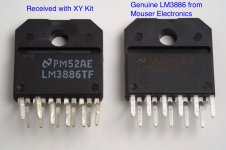 Fake_vs_Real_LM3886_Annotated.jpg144 KB · Views: 7,041
Fake_vs_Real_LM3886_Annotated.jpg144 KB · Views: 7,041 -
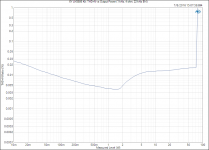 XY LM3886 Kit_ THD+N vs Output Power (1 kHz, 4 ohm, 22 kHz BW).PNG44.6 KB · Views: 2,086
XY LM3886 Kit_ THD+N vs Output Power (1 kHz, 4 ohm, 22 kHz BW).PNG44.6 KB · Views: 2,086 -
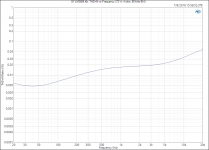 XY LM3886 Kit_ THD+N vs Frequency (72 W, 4 ohm, 80 kHz BW).PNG27.8 KB · Views: 2,046
XY LM3886 Kit_ THD+N vs Frequency (72 W, 4 ohm, 80 kHz BW).PNG27.8 KB · Views: 2,046 -
 XY LM3886 Kit_ THD+N vs Output Power (1 kHz, 8 ohm, 22 kHz BW).png43 KB · Views: 2,126
XY LM3886 Kit_ THD+N vs Output Power (1 kHz, 8 ohm, 22 kHz BW).png43 KB · Views: 2,126 -
 XY LM3886 Kit_ THD+N vs Frequency (43 W, 8 ohm, 80 kHz BW).PNG27.5 KB · Views: 5,531
XY LM3886 Kit_ THD+N vs Frequency (43 W, 8 ohm, 80 kHz BW).PNG27.5 KB · Views: 5,531 -
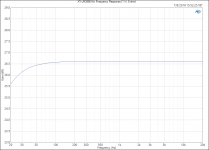 XY LM3886 Kit_ Frequency Response (1 W, 8 ohm).png37.8 KB · Views: 5,944
XY LM3886 Kit_ Frequency Response (1 W, 8 ohm).png37.8 KB · Views: 5,944 -
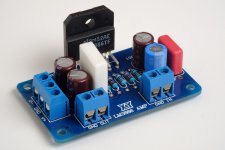 XY_LM3886_Kit_ASSY.jpg173.6 KB · Views: 5,962
XY_LM3886_Kit_ASSY.jpg173.6 KB · Views: 5,962 -
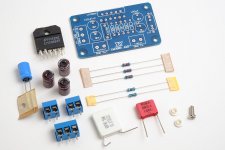 XY_LM3886_Kit.jpg152.7 KB · Views: 6,059
XY_LM3886_Kit.jpg152.7 KB · Views: 6,059 -
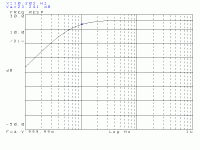 XY_LM3886_Kit_FrequencyResponseLF.gif11.9 KB · Views: 1,925
XY_LM3886_Kit_FrequencyResponseLF.gif11.9 KB · Views: 1,925 -
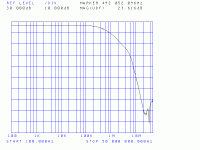 XY_LM3886_Kit_FrequencyResponse.gif16.8 KB · Views: 2,094
XY_LM3886_Kit_FrequencyResponse.gif16.8 KB · Views: 2,094
Last edited:
Now for the time domain measurements. I show the step response into an 8 Ω load with a capacitor in parallel. This is a common test of amplifier stability. The 0.15 Ω*resistor in series with the amplifier output does a half-decent job at keeping the amplifier stable, although, at 72 W into 4 Ω output power, the resistor reaches a temperature of over 150 ºC!
Note that the first signs of trouble driving a capacitive load start already at 10 nF where a small step is shown in the response just before it hits the horizontal part of the square wave. At 100 nF this is even more pronounced and at 220 nF we have full-blown instability. Thankfully, the amp recovers pretty quickly and gracefully.
The sine wave shows no surprises. It's ... a sine wave. 🙂
Tom
Note that the first signs of trouble driving a capacitive load start already at 10 nF where a small step is shown in the response just before it hits the horizontal part of the square wave. At 100 nF this is even more pronounced and at 220 nF we have full-blown instability. Thankfully, the amp recovers pretty quickly and gracefully.
The sine wave shows no surprises. It's ... a sine wave. 🙂
Tom
Attachments
-
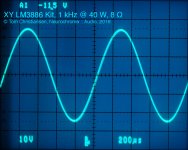 XY_Sine.jpg157.5 KB · Views: 846
XY_Sine.jpg157.5 KB · Views: 846 -
 XY_Transient_1uF8R.jpg161.7 KB · Views: 774
XY_Transient_1uF8R.jpg161.7 KB · Views: 774 -
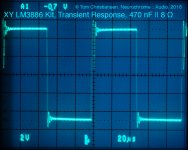 XY_Transient_470nF8R.jpg157.8 KB · Views: 644
XY_Transient_470nF8R.jpg157.8 KB · Views: 644 -
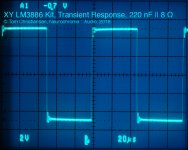 XY_Transient_220nF8R.jpg154.3 KB · Views: 620
XY_Transient_220nF8R.jpg154.3 KB · Views: 620 -
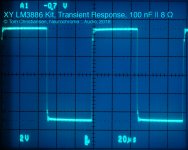 XY_Transient_100nF8R.jpg154 KB · Views: 571
XY_Transient_100nF8R.jpg154 KB · Views: 571 -
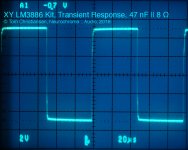 XY_Transient_47nF8R.jpg154.4 KB · Views: 542
XY_Transient_47nF8R.jpg154.4 KB · Views: 542 -
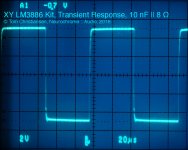 XY_Transient_10nF8R.jpg155 KB · Views: 577
XY_Transient_10nF8R.jpg155 KB · Views: 577 -
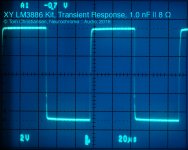 XY_Transient_1nF8R.jpg155.1 KB · Views: 658
XY_Transient_1nF8R.jpg155.1 KB · Views: 658 -
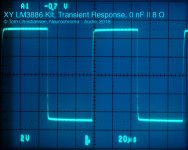 XY_Transient_0nF8R.jpg152.5 KB · Views: 1,185
XY_Transient_0nF8R.jpg152.5 KB · Views: 1,185
The clipping response looks like a classic LM3886 clipping response. There's a little rail sticking on the negative rail, but that's common on the LM3886 and not a cause for concern. I was actually a bit surprised that the clipping response of the XY LM3886 Kit is so clean as the kit does NOT implement the components recommended to ensure stability near clipping. Rather, XY uses a 0.15 Ω, 5 W power resistor in series with the amplifier output. That's a bit wasteful on power (hence 72 W into 4 Ω rather than the 80 W I measure on my LM3886DR), but seems to work well for stability near the supply rails.
The temperature coefficient of the 0.15 Ω output resistor appears to be quite large. As a result, the output power droops considerably as shown in the output power vs time graph. I included the THD+N vs time plot as well for show & tell.
I've included the IMD measurements (both SMPTE and 18k:19k) and the multi-tone IMD measurement. The multi-tone test uses 32 tones logarithmically spaced from 16 Hz to 20 kHz. This signal sounds like an out-of-tune pipe organ and is representative of a music signal. The interesting piece of this measurement is the "grass" that grows near the high end of the spectrum. The taller the grass the worse the sound quality.
Finally, I show the harmonic spectra for full output power (43 W, 8 Ω and 72 W, 4 Ω).
Tom
The temperature coefficient of the 0.15 Ω output resistor appears to be quite large. As a result, the output power droops considerably as shown in the output power vs time graph. I included the THD+N vs time plot as well for show & tell.
I've included the IMD measurements (both SMPTE and 18k:19k) and the multi-tone IMD measurement. The multi-tone test uses 32 tones logarithmically spaced from 16 Hz to 20 kHz. This signal sounds like an out-of-tune pipe organ and is representative of a music signal. The interesting piece of this measurement is the "grass" that grows near the high end of the spectrum. The taller the grass the worse the sound quality.
Finally, I show the harmonic spectra for full output power (43 W, 8 Ω and 72 W, 4 Ω).
Tom
Attachments
-
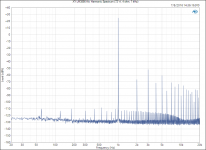 XY LM3886 Kit_ Harmonic Spectrum (72 W, 4 ohm, 1 kHz).PNG57 KB · Views: 723
XY LM3886 Kit_ Harmonic Spectrum (72 W, 4 ohm, 1 kHz).PNG57 KB · Views: 723 -
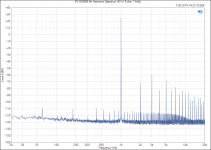 XY LM3886 Kit_ Harmonic Spectrum (43 W, 8 ohm, 1 kHz).PNG47.9 KB · Views: 2,390
XY LM3886 Kit_ Harmonic Spectrum (43 W, 8 ohm, 1 kHz).PNG47.9 KB · Views: 2,390 -
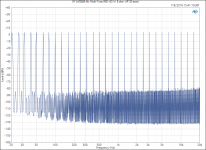 XY LM3886 Kit_ Multi-Tone IMD (43 W, 8 ohm, AP 32-tone).png85.7 KB · Views: 652
XY LM3886 Kit_ Multi-Tone IMD (43 W, 8 ohm, AP 32-tone).png85.7 KB · Views: 652 -
 XY LM3886 Kit_ IMD (DFD, 18+19 kHz, 1_1, 43 W, 8 ohm).PNG34 KB · Views: 532
XY LM3886 Kit_ IMD (DFD, 18+19 kHz, 1_1, 43 W, 8 ohm).PNG34 KB · Views: 532 -
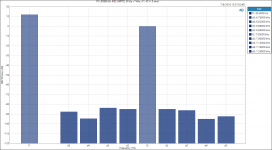 XY LM3886 Kit_ IMD (SMPTE, 60 Hz + 7 kHz, 4_1, 43 W, 8 ohm).png41.7 KB · Views: 525
XY LM3886 Kit_ IMD (SMPTE, 60 Hz + 7 kHz, 4_1, 43 W, 8 ohm).png41.7 KB · Views: 525 -
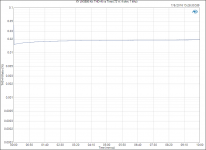 XY LM3886 Kit_ THD+N vs Time (72 W, 4 ohm, 1 kHz).png23.4 KB · Views: 540
XY LM3886 Kit_ THD+N vs Time (72 W, 4 ohm, 1 kHz).png23.4 KB · Views: 540 -
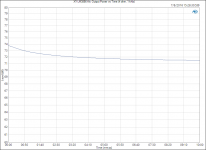 XY LM3886 Kit_ Output Power vs Time (4 ohm, 1 kHz).PNG23.4 KB · Views: 681
XY LM3886 Kit_ Output Power vs Time (4 ohm, 1 kHz).PNG23.4 KB · Views: 681 -
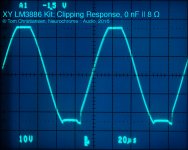 XY_Clipping.jpg155.2 KB · Views: 615
XY_Clipping.jpg155.2 KB · Views: 615 -
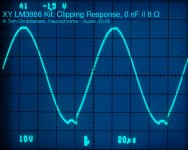 XY_ClippingOnset.jpg155 KB · Views: 720
XY_ClippingOnset.jpg155 KB · Views: 720
Battle of The Amps: I decided to compare the performance of the XY Kit with that of my LM3886 Done Right. You can see the obvious differences in attached plots. The two amps were mounted on identical 0.4 K/W heat sinks using identical Aavid spring steel mounting clips and tested using the exact same setup.
Conclusion: You get what you pay for. My LM3886DR beats the data sheet performance of the LM3886 on midrange THD+N. The XY kit struggles to meet the data sheet performance of the LM3886 at any point of the THD+N curve and is over 10 dB worse than the LM3886 data sheet performance at output powers exceeding 2 W. This combined with the marginal stability under capacitive load and lacking RFI/EMI input filter leaves me thinking that while you do kinda-sorta get your $11 worth with the XY kit, there is certainly room for improvement. Considering that the majority of the build cost of an LM3886-based amplifier is the power supply, heat sinks, connectors, and chassis, I truly believe that buying amplifier kits on eBay is a false economy in the majority of cases. I'm sure there are exceptions (I sell on eBay sometimes, for example), but the XY "LM3886" Kit does not appear to be one of the exceptions.
Those interested in all the measurements of the LM3886DR, please see the graphs I uploaded to the LM3886DR thread in the Vendor's Bazaar.
Tom
Conclusion: You get what you pay for. My LM3886DR beats the data sheet performance of the LM3886 on midrange THD+N. The XY kit struggles to meet the data sheet performance of the LM3886 at any point of the THD+N curve and is over 10 dB worse than the LM3886 data sheet performance at output powers exceeding 2 W. This combined with the marginal stability under capacitive load and lacking RFI/EMI input filter leaves me thinking that while you do kinda-sorta get your $11 worth with the XY kit, there is certainly room for improvement. Considering that the majority of the build cost of an LM3886-based amplifier is the power supply, heat sinks, connectors, and chassis, I truly believe that buying amplifier kits on eBay is a false economy in the majority of cases. I'm sure there are exceptions (I sell on eBay sometimes, for example), but the XY "LM3886" Kit does not appear to be one of the exceptions.
Those interested in all the measurements of the LM3886DR, please see the graphs I uploaded to the LM3886DR thread in the Vendor's Bazaar.
Tom
Attachments
-
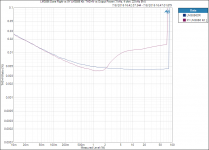 LM3886 Done Right vs XY LM3886 Kit_ THD+N vs Output Power (1 kHz, 4 ohm, 22 kHz BW).PNG55.7 KB · Views: 1,813
LM3886 Done Right vs XY LM3886 Kit_ THD+N vs Output Power (1 kHz, 4 ohm, 22 kHz BW).PNG55.7 KB · Views: 1,813 -
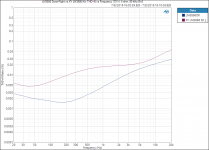 LM3886 Done Right vs XY LM3886 Kit_ THD+N vs Frequency (70 W, 4 ohm, 80 kHz BW).PNG33.4 KB · Views: 1,719
LM3886 Done Right vs XY LM3886 Kit_ THD+N vs Frequency (70 W, 4 ohm, 80 kHz BW).PNG33.4 KB · Views: 1,719 -
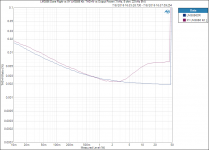 LM3886 Done Right vs XY LM3886 Kit_ THD+N vs Output Power (1 kHz, 8 ohm, 22 kHz BW).PNG49.4 KB · Views: 2,353
LM3886 Done Right vs XY LM3886 Kit_ THD+N vs Output Power (1 kHz, 8 ohm, 22 kHz BW).PNG49.4 KB · Views: 2,353 -
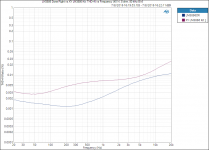 LM3886 Done Right vs XY LM3886 Kit_ THD+N vs Frequency (40 W, 8 ohm, 80 kHz BW).PNG33 KB · Views: 2,527
LM3886 Done Right vs XY LM3886 Kit_ THD+N vs Frequency (40 W, 8 ohm, 80 kHz BW).PNG33 KB · Views: 2,527 -
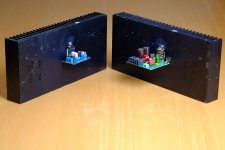 BattleOfTheAmps.jpg184.6 KB · Views: 2,263
BattleOfTheAmps.jpg184.6 KB · Views: 2,263
Last edited:
Honesty and science is a beautiful thing. The differences are abundantly clear to a dimwit like myself!
Caveat Emptor folks!
Anand.
Caveat Emptor folks!
Anand.
The differences are clear Tom!
Great job for designing a nice amp, but comparing yours with a kit from Chinese eBay seller it's not that recommended.
Now Tom , why did you buy the kit? Who buys the kit? You buy the pcb and buy the components by yourself. At one point in your review you said that your kit is 5 times more than the Chinese one. What???? let me help you with the math. Your pcb sells for 35$, stereo is 70$, but that's not the kit. Your populated board sells for over 150$, stereo is over 300, that makes it at least over 20 times more expensive than the Chinese one.
I thought you launched your amp because people at chipamp.com were not doing a good job fulfilling their orders, so you wanted to help people looking for an affordable amp.
But the chipamp.com amp kit (stereo) are sold for almost the same price that you sell the 2 pcb.
And they sell their pcb 2pcb for lm 3886 amp + 2 psu for24$ ....
So I don't see how you going to get that part of the market.
I think your LM3886 Done Right is a good one , but you have to do something about the prices. The other amp , Modulus-86 is a great amp too , but again , a little expensive....maybe I was a little bit harsh , but ....
Does anybody else shares the same thoughts?
Great job for designing a nice amp, but comparing yours with a kit from Chinese eBay seller it's not that recommended.
Now Tom , why did you buy the kit? Who buys the kit? You buy the pcb and buy the components by yourself. At one point in your review you said that your kit is 5 times more than the Chinese one. What???? let me help you with the math. Your pcb sells for 35$, stereo is 70$, but that's not the kit. Your populated board sells for over 150$, stereo is over 300, that makes it at least over 20 times more expensive than the Chinese one.
I thought you launched your amp because people at chipamp.com were not doing a good job fulfilling their orders, so you wanted to help people looking for an affordable amp.
But the chipamp.com amp kit (stereo) are sold for almost the same price that you sell the 2 pcb.
And they sell their pcb 2pcb for lm 3886 amp + 2 psu for24$ ....
So I don't see how you going to get that part of the market.
I think your LM3886 Done Right is a good one , but you have to do something about the prices. The other amp , Modulus-86 is a great amp too , but again , a little expensive....maybe I was a little bit harsh , but ....
Does anybody else shares the same thoughts?
Last edited:
I think your LM3886 Done Right is a good one , but you have to do something about the prices.
No, he doesn't. Tom is free to sell his product(s) at whatever price point(s) he establishes. You, as a possible customer, are free to evaluate and decide not to purchase if you so choose.
I also don't have any problem with objective comparisons of competing products. It happens all the time.
Dave.
No, he doesn't. Tom is free to sell his product(s) at whatever price point(s) he establishes. You, as a possible customer, are free to evaluate and decide not to purchase if you so choose.
I also don't have any problem with objective comparisons of competing products. It happens all the time.
Dave.
Thanks Dave! I agree wholeheartedly! For a fully built board you are paying for the soldering, cleaning AND testing! Tom guarantees that the built board matches the prototype!
Let's credit the engineers for what they do!
The penny pinchers can choose more incompetently designed circuits & boards 😱
Best,
Anand.
I also think having some objective measurements is a good thing. Few of us can afford 20k+ on an audio tester let alone have time to learn how to drive the beast properly (a fool with a tool is still a fool after all). The fact that Tom is willing to spend some of his limited free time testing building and testing this accurately should be welcomed.
Looking at the plots you could easily say that (stability aside) the XY still has low enough THD to be below known audibility thresholds and so into a benign speaker should be audibly transparent. Would love to know the history behind the printed chips tho.
Looking at the plots you could easily say that (stability aside) the XY still has low enough THD to be below known audibility thresholds and so into a benign speaker should be audibly transparent. Would love to know the history behind the printed chips tho.
Great job for designing a nice amp, but comparing yours with a kit from Chinese eBay seller it's not that recommended.
Why not? I think it's pretty reasonable to compare one LM3886 design with another. With objective measurements prospective customers can make informed choices.
Now Tom , why did you buy the kit?
To be able to contrast the best eBay board I could find with my own circuit. It's done all the time in the industry. It's known as competitive analysis.
At one point in your review you said that your kit is 5 times more than the Chinese one. What???? let me help you with the math.
No help needed, thanks.
My board: $35+27 in parts = $62
XY eBay board: $11.99 (current on sale price).
62/11.99 = 5.171. Is that not close enough to 5x for you?
I think your LM3886 Done Right is a good one , but you have to do something about the prices. The other amp , Modulus-86 is a great amp too , but again , a little expensive....maybe I was a little bit harsh , but ....
Does anybody else shares the same thoughts?
Lots of people agree with you that qualified engineers and technicians should just provide their work for free, so you're in good company there.
My value-add is that I deliver circuits which are well designed, well tested, well characterized, well documented, and well supported. I deliver *A LOT* of support as any of my customers can attest. I cannot deliver a quality product for free or at cost. I run a business and I believe in it to the point where I have chosen to make it my only source of income. However, in order for my business to provide any income at all, the revenue must exceed the expenses. That's how businesses work.
You are correct that Chipamp charges less for their boards than I do. They charge $6 + shipping for their LM3886 board and $20 for board + parts. That's below my cost. In addition, Chipamp's boards do NOT include the components necessary for good stability neither good stability near clipping nor good stability with capacitive loads. Furthermore, their supply routing is about the worst you can get for rail-induced distortion. I would have loved to perform my competitive analysis against one of Chipamp's boards, but they don't seem to be able to deliver products or communicate with their customers. It's to the point where people have to file Paypal disputes to get their money back. That's very unfortunate, but it's their choice and not mine.
You are also correct that it was the threads about people's trouble dealing with Chipamp that was the push I needed to design the LM3886DR board. I've been thinking about it for a while and now the opportunity to fill a hole in the market was there. That said, I cannot compete on price for reasons mentioned earlier. Instead I compete on engineering, characterization, documentation, and support. Quality of product in other words. I ship the vast majority of orders within 24 hours of receipt. Those that take longer are custom orders and fully assembled boards. My website keeps track of the inventory and if it says a product is in stock, it is in stock and will be shipped in a timely fashion.
If quality is not your thing - and that's totally fair if it isn't - there are other options to choose from.
Tom
Last edited:
No, he doesn't. Tom is free to sell his product(s) at whatever price point(s) he establishes. You, as a possible customer, are free to evaluate and decide not to purchase if you so choose.
I also don't have any problem with objective comparisons of competing products. It happens all the time.
Exactly!
For a fully built board you are paying for the soldering, cleaning AND testing! Tom guarantees that the built board matches the prototype!
Absolutely correct. Any assembled amplifier board that you order from me gets checked out on the Audio Precision APx525 to ensure that it performs well before I ship it. That's part of what you pay for.
I also think having some objective measurements is a good thing. Few of us can afford 20k+ on an audio tester let alone have time to learn how to drive the beast properly (a fool with a tool is still a fool after all). The fact that Tom is willing to spend some of his limited free time testing building and testing this accurately should be welcomed.
Thank you.
Looking at the plots you could easily say that (stability aside) the XY still has low enough THD to be below known audibility thresholds and so into a benign speaker should be audibly transparent.
Maybe... I have yet to hook up the XY board to the stereo. It would not surprise me at all if that rather extreme jump in THD+N above 2 W is quite audible.
Would love to know the history behind the printed chips tho.
Me too. I'll post to this thread if/when I have sharable results from TI's analysis.
Tom
Okay , looks like I have to clear the waters.
First thing, it's bad to compare 11$ Kit with 35$ pcb, like you compare Kia with Ferrari ....that's why I got started, it's not fair , and even the chip was fake
And why did you spend 11$ for that kit? I thought it's a stereo one,not mono!
Tom, you got ripped off, these eBay sellers made you pay more than you sHould.
I did not mean that you need to lower the prices for me. No , thank you! For you , for your business ! But dont worry about me or the other customers!
I did not mean to upset anybody
First thing, it's bad to compare 11$ Kit with 35$ pcb, like you compare Kia with Ferrari ....that's why I got started, it's not fair , and even the chip was fake
And why did you spend 11$ for that kit? I thought it's a stereo one,not mono!
Tom, you got ripped off, these eBay sellers made you pay more than you sHould.
I did not mean that you need to lower the prices for me. No , thank you! For you , for your business ! But dont worry about me or the other customers!
I did not mean to upset anybody
Last edited:
The LM3886 chips are fakes, Chinese sellers offer them for £1 a piece. They do fail - I know it because I bought some from a local diy-er some time ago and have used them. They are very different from the TI branded ones I also buy from Mouser.
In Jeff Rowland lm amp... not a 11 dollar amp 😕
Jeff probably buys his LM3886es from a TI distributor. He uses a 0.5 Ω ballast resistor as he's running multiple LM3886es in parallel. He probably also paid attention to the component selection on that 0.5 Ω resistor and chose one with a low temperature coefficient.
Tom
Okay here comes the stupid question: So is the XY kit any good for anything?
There is a whole thread addressing mods of that kit. Anyone tried it?
Just curious as I have the XY pcb's laying here. LM's bought from a serious place - no fakes.
There is a whole thread addressing mods of that kit. Anyone tried it?
Just curious as I have the XY pcb's laying here. LM's bought from a serious place - no fakes.
I just bought those xy-boards to put together as my first diy amp. And then I read that it could be fake lm's... Mmm. Might as well use them now, but in the future I will purchase with a little more wisdom.
This comparison is not unfair because of the price difference.
Its invalid because one board uses known genuine components and the other known fake components.
Its invalid because one board uses known genuine components and the other known fake components.
Tom, I have a few unused Chipamp.com boards lying around if you'd like me send you one. It would be interesting to see how it compares... I could send it populated with all the R's & C's from their kit too if you like...
John
John
Tom,
Can you help with THD vs frequency - comparison - at 1W? It's probably, given what I remember you posting at some point, more representative power level for normal listening.
No question yours has the edge at high power outputs, but it's not like we listen at those power levels anyway. I know for a fact that the XY board is quite poorly designed, specially around the feedback ground, but some P2P techniques help with that gremlin.
Not trying to diss your product, just curious as the 1W performance seems quite comparable for both products so am keen to see how it was distributed over frequency. Some FFTs would also be nice, if possible.
Can you help with THD vs frequency - comparison - at 1W? It's probably, given what I remember you posting at some point, more representative power level for normal listening.
No question yours has the edge at high power outputs, but it's not like we listen at those power levels anyway. I know for a fact that the XY board is quite poorly designed, specially around the feedback ground, but some P2P techniques help with that gremlin.
Not trying to diss your product, just curious as the 1W performance seems quite comparable for both products so am keen to see how it was distributed over frequency. Some FFTs would also be nice, if possible.
- Home
- Amplifiers
- Chip Amps
- XY LM3886 Kit Review & Measurements
